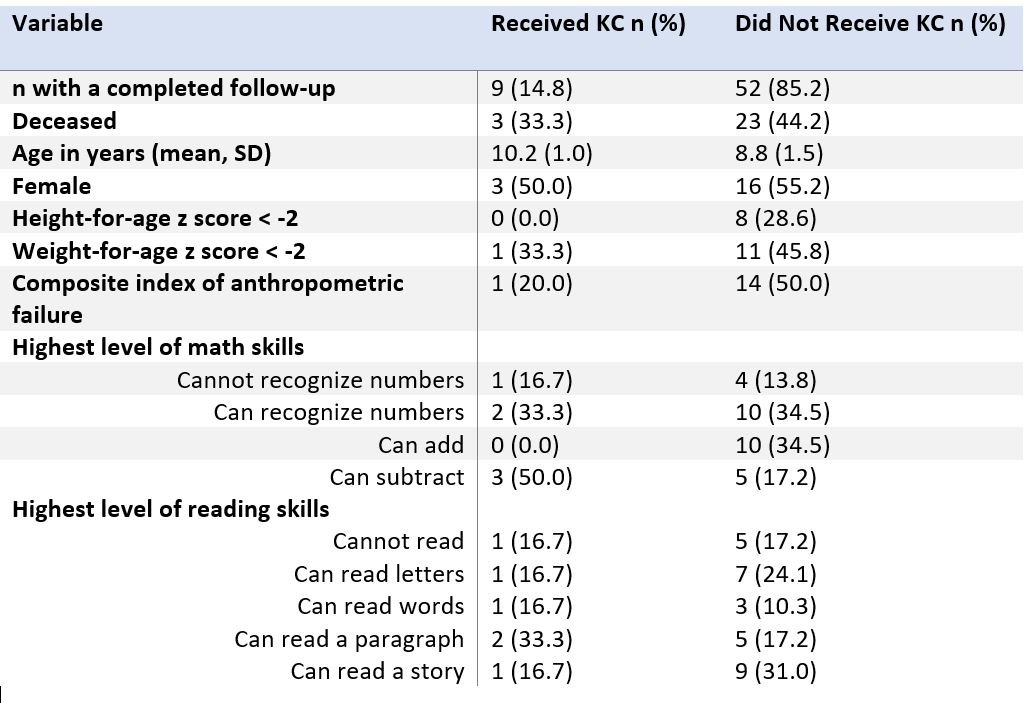Global Neonatal & Children's Health
Category: Abstract Submission
Global Child and Adolescent Health III
524 - Effect of Kangaroo Care on Pre-adolescent Outcomes: 10-year NICU Follow-up
Sunday, April 24, 2022
3:30 PM - 6:00 PM US MT
Poster Number: 524
Publication Number: 524.318
Publication Number: 524.318
Nisha M. Fahey, UMass Chan Medical School, Worcester, MA, United States; Binoy V. Shah, Bhaikaka University, Anand, Gujarat, India; emily gang, University of Massachusetts Medical School, Ashland, MA, United States; Dhwani A. Patel, BHAIKAKA UNIVERSITY,ANAND, Gandhinagar, Gujarat, India; Amee A. Amin, Charleston Area Medical Center/ WVU, Charleston, WV, United States; Dipen V. Patel, Bhiakaka University, Karamsad, Gujarat, India; Lawrence Rhein, University of Massachusetts Medical School, Waban, MA, United States; Apurv Soni, University of Massachusetts Medical School, Worcester, MA, United States; Somashekhar M. Nimbalkar, Bhaikaka University, Karamsad, Gujarat, India; Jeroan Allison, UMass Chan Medical School, Worcester, MA, United States
.jpg)
Nisha Fahey, DO, MSc (she/her/hers)
Assistant Professor
UMass Chan Medical School
Worcester, Massachusetts, United States
Presenting Author(s)
Background: Fifteen to twenty percent of all births worldwide are low birth weight or premature, one quarter of which occur in India, making it the epicenter of this crisis. Kangaroo Care is a low-cost method that can mitigate the consequences of low birth weight and prematurity; however, it is yet to be widely accepted and integrated in routine neonatal care.
Objective: Understand the potential long-term benefits of Kangaroo Care (KC) among former neonates who were admitted to a Neonatal Intensive Care Unit (NICU) in rural western India
Design/Methods: This prospective cohort study investigated physical growth, cognitive development, and morbidity outcomes among pre-adolescent children based on their exposure to KC during the neonatal period while hospitalized in the NICU. The cohort is comprised of 648 neonates hospitalized in a NICU in rural Anand, Gujarat, India between 2010 and 2014 who are now between the ages of 7-11 years old. Home visits are underway to collect data about their current physical growth utilizing standardized anthropometric measures developed by the WHO, cognitive development using validated aptitude measures developed for use in India among children, and co-morbidities based on India Human Development Survey questions as well as visual and hearing assessment.
Results: Of the 648 former neonates in the cohort, 50.6% had received KC in the NICU for an average of 3.9 hours per day (SD: 2.3). From November 2021 through December 2021, 61 follow-up encounters have been completed at a pace of 10 follow-ups per week. Among these children, 26 (42.6%) were identified as deceased. Table 1 provides the distribution of characteristics for the follow-up encounters stratified by exposure to KC in the NICU. These early data show a trend toward better survival and anthropometric outcomes among children who received KC in the NICU compared to those who did not. The observed effect estimate of at least 10% will be statistically significant at the 95% confidence level once at least 291 follow-up encounters are completed.Conclusion(s): This is the first longitudinal study of the impact of KC in India that spans beyond infancy and measures objective outcomes that are important public health markers. Additional data from ongoing follow-up encounters will increase the power to detect differences in outcomes and allow for adjustment for confounding variables. Understanding the long-term benefits of KC among neonates will support the development of public health policy focused on increasing awareness and practice of Kangaroo Care.
Table 1: Outcomes of follow-up encounters among pre-adolescent children with and without exposure to kangaroo care (KC) during NICU hospitalization in rural western India
Objective: Understand the potential long-term benefits of Kangaroo Care (KC) among former neonates who were admitted to a Neonatal Intensive Care Unit (NICU) in rural western India
Design/Methods: This prospective cohort study investigated physical growth, cognitive development, and morbidity outcomes among pre-adolescent children based on their exposure to KC during the neonatal period while hospitalized in the NICU. The cohort is comprised of 648 neonates hospitalized in a NICU in rural Anand, Gujarat, India between 2010 and 2014 who are now between the ages of 7-11 years old. Home visits are underway to collect data about their current physical growth utilizing standardized anthropometric measures developed by the WHO, cognitive development using validated aptitude measures developed for use in India among children, and co-morbidities based on India Human Development Survey questions as well as visual and hearing assessment.
Results: Of the 648 former neonates in the cohort, 50.6% had received KC in the NICU for an average of 3.9 hours per day (SD: 2.3). From November 2021 through December 2021, 61 follow-up encounters have been completed at a pace of 10 follow-ups per week. Among these children, 26 (42.6%) were identified as deceased. Table 1 provides the distribution of characteristics for the follow-up encounters stratified by exposure to KC in the NICU. These early data show a trend toward better survival and anthropometric outcomes among children who received KC in the NICU compared to those who did not. The observed effect estimate of at least 10% will be statistically significant at the 95% confidence level once at least 291 follow-up encounters are completed.Conclusion(s): This is the first longitudinal study of the impact of KC in India that spans beyond infancy and measures objective outcomes that are important public health markers. Additional data from ongoing follow-up encounters will increase the power to detect differences in outcomes and allow for adjustment for confounding variables. Understanding the long-term benefits of KC among neonates will support the development of public health policy focused on increasing awareness and practice of Kangaroo Care.
Table 1: Outcomes of follow-up encounters among pre-adolescent children with and without exposure to kangaroo care (KC) during NICU hospitalization in rural western India

